2007 FORD FREESTAR warning lights
[x] Cancel search: warning lightsPage 211 of 312
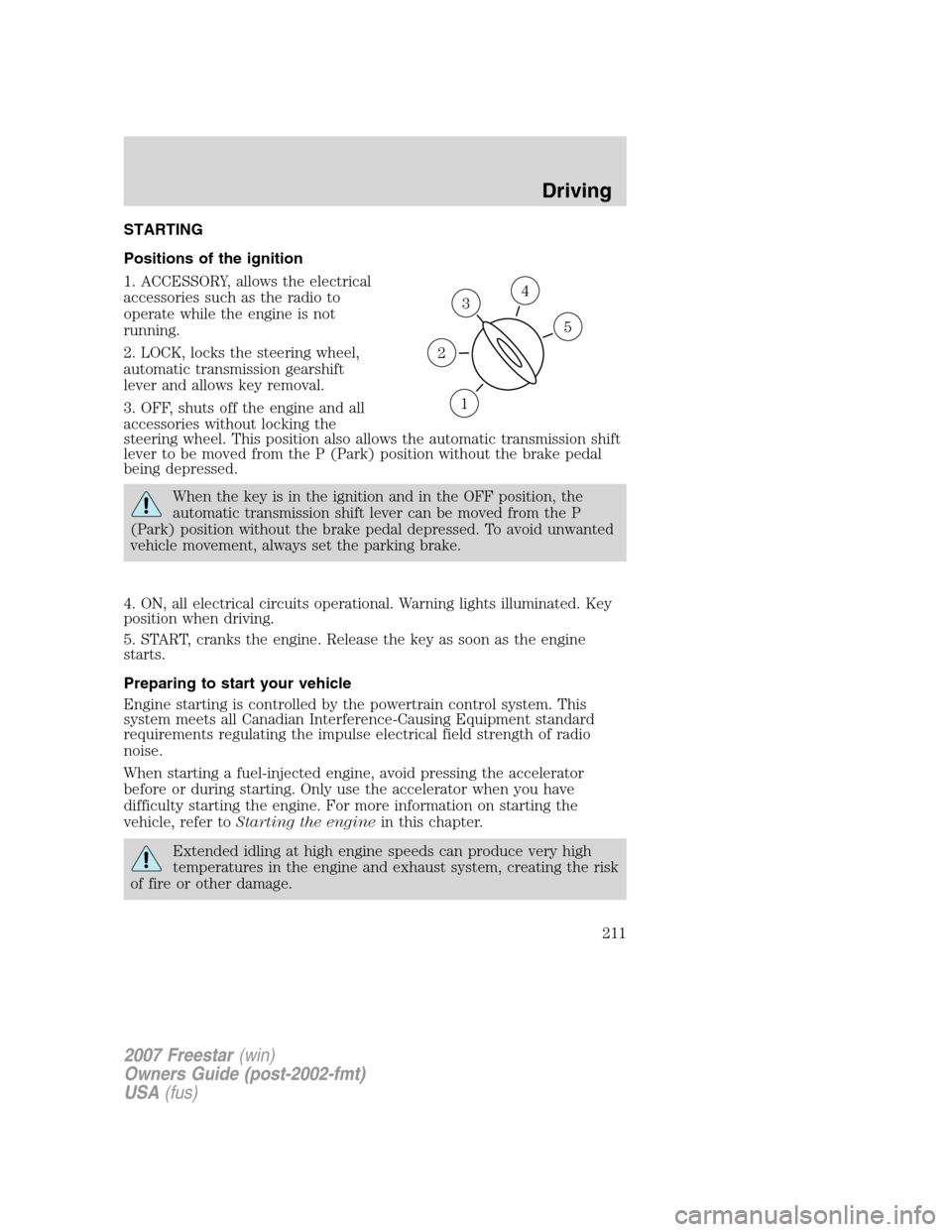
STARTING
Positions of the ignition
1. ACCESSORY, allows the electrical
accessories such as the radio to
operate while the engine is not
running.
2. LOCK, locks the steering wheel,
automatic transmission gearshift
lever and allows key removal.
3. OFF, shuts off the engine and all
accessories without locking the
steering wheel. This position also allows the automatic transmission shift
lever to be moved from the P (Park) position without the brake pedal
being depressed.
When the key is in the ignition and in the OFF position, the
automatic transmission shift lever can be moved from the P
(Park) position without the brake pedal depressed. To avoid unwanted
vehicle movement, always set the parking brake.
4. ON, all electrical circuits operational. Warning lights illuminated. Key
position when driving.
5. START, cranks the engine. Release the key as soon as the engine
starts.
Preparing to start your vehicle
Engine starting is controlled by the powertrain control system. This
system meets all Canadian Interference-Causing Equipment standard
requirements regulating the impulse electrical field strength of radio
noise.
When starting a fuel-injected engine, avoid pressing the accelerator
before or during starting. Only use the accelerator when you have
difficulty starting the engine. For more information on starting the
vehicle, refer toStarting the enginein this chapter.
Extended idling at high engine speeds can produce very high
temperatures in the engine and exhaust system, creating the risk
of fire or other damage.
3
1
2
5
4
2007 Freestar(win)
Owners Guide (post-2002-fmt)
USA(fus)
Driving
211
Page 213 of 312
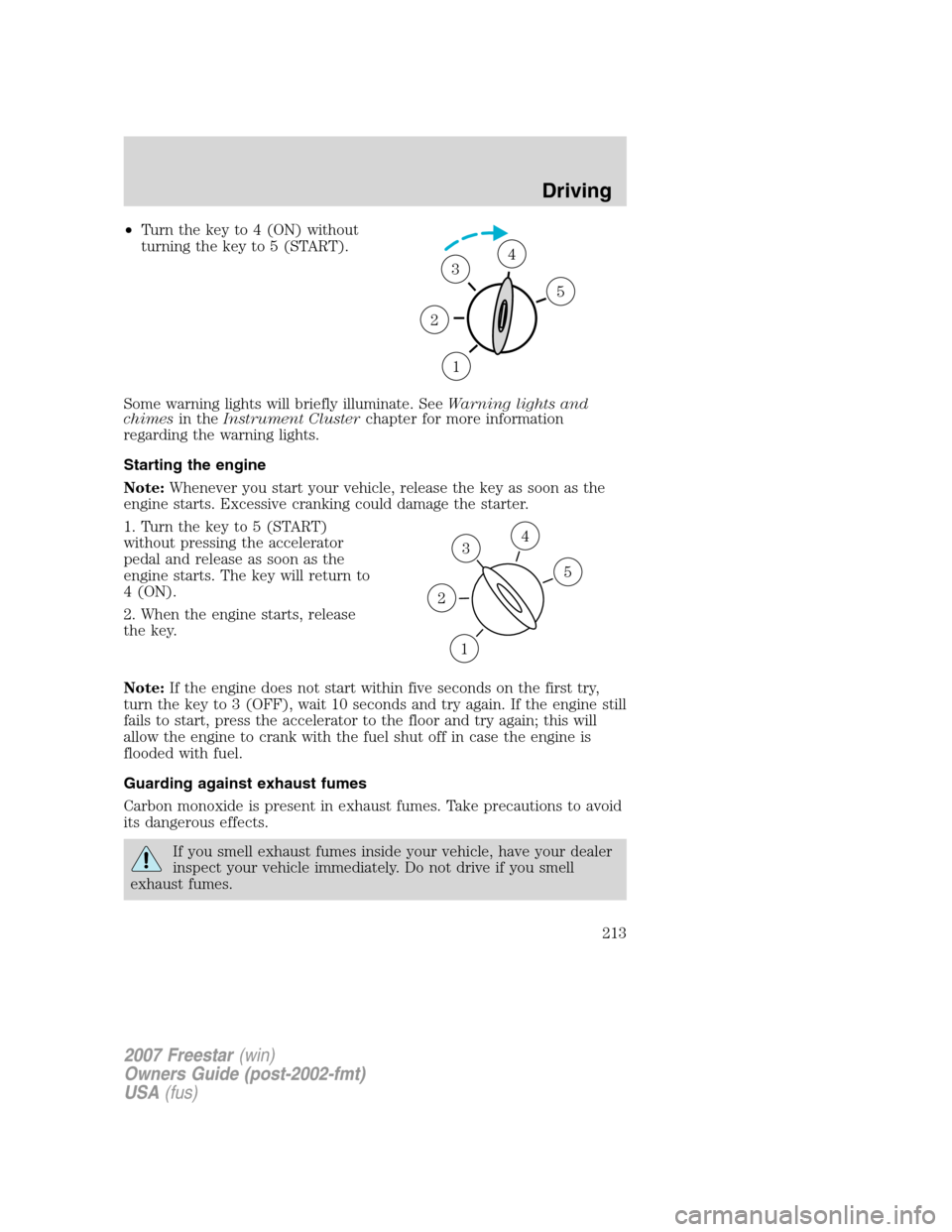
•Turn the key to 4 (ON) without
turning the key to 5 (START).
Some warning lights will briefly illuminate. SeeWarning lights and
chimesin theInstrument Clusterchapter for more information
regarding the warning lights.
Starting the engine
Note:Whenever you start your vehicle, release the key as soon as the
engine starts. Excessive cranking could damage the starter.
1. Turn the key to 5 (START)
without pressing the accelerator
pedal and release as soon as the
engine starts. The key will return to
4 (ON).
2. When the engine starts, release
the key.
Note:If the engine does not start within five seconds on the first try,
turn the key to 3 (OFF), wait 10 seconds and try again. If the engine still
fails to start, press the accelerator to the floor and try again; this will
allow the engine to crank with the fuel shut off in case the engine is
flooded with fuel.
Guarding against exhaust fumes
Carbon monoxide is present in exhaust fumes. Take precautions to avoid
its dangerous effects.
If you smell exhaust fumes inside your vehicle, have your dealer
inspect your vehicle immediately. Do not drive if you smell
exhaust fumes.
1
2
34
5
3
1
2
5
4
2007 Freestar(win)
Owners Guide (post-2002-fmt)
USA(fus)
Driving
213
Page 286 of 312
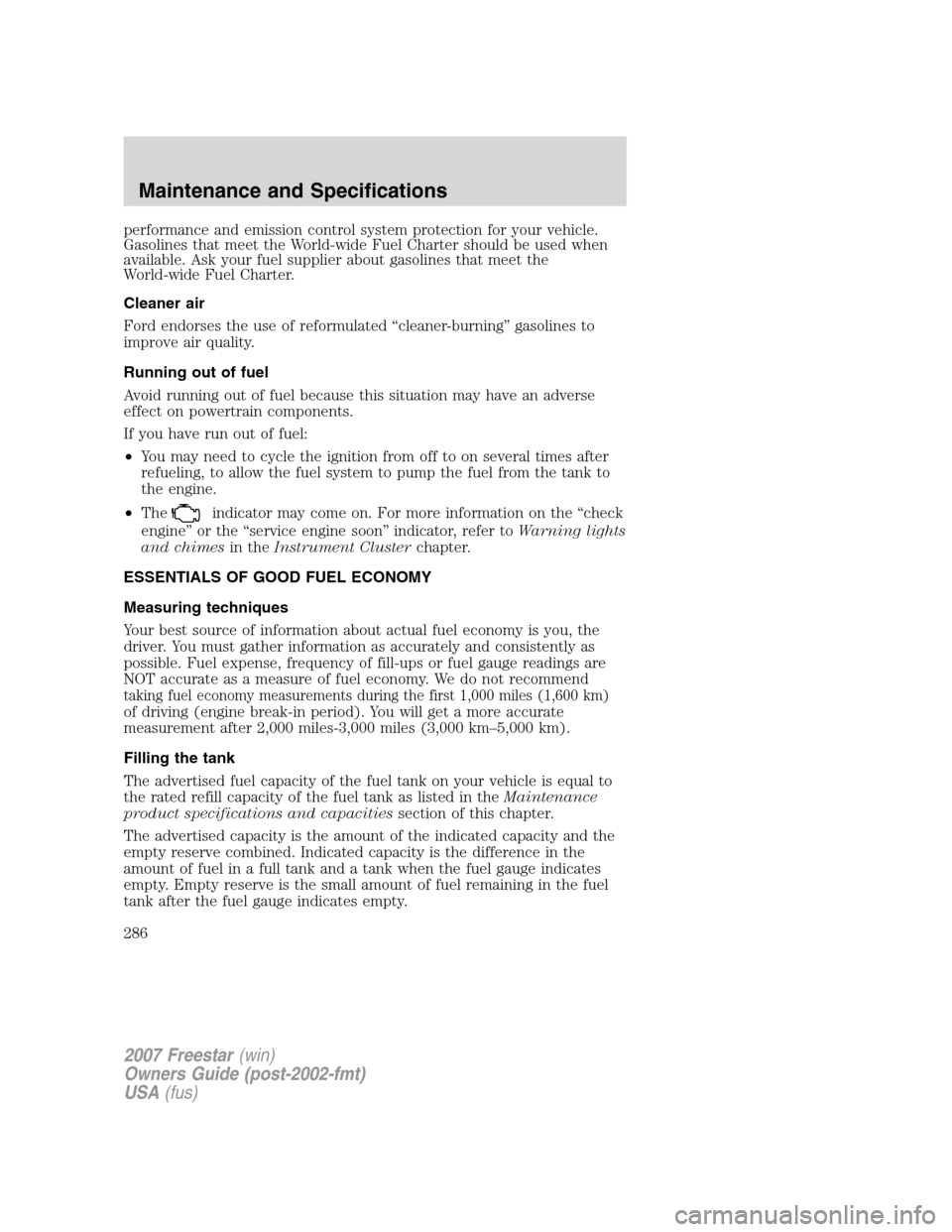
performance and emission control system protection for your vehicle.
Gasolines that meet the World-wide Fuel Charter should be used when
available. Ask your fuel supplier about gasolines that meet the
World-wide Fuel Charter.
Cleaner air
Ford endorses the use of reformulated “cleaner-burning” gasolines to
improve air quality.
Running out of fuel
Avoid running out of fuel because this situation may have an adverse
effect on powertrain components.
If you have run out of fuel:
•You may need to cycle the ignition from off to on several times after
refueling, to allow the fuel system to pump the fuel from the tank to
the engine.
•The
indicator may come on. For more information on the “check
engine” or the “service engine soon” indicator, refer toWarning lights
and chimesin theInstrument Clusterchapter.
ESSENTIALS OF GOOD FUEL ECONOMY
Measuring techniques
Your best source of information about actual fuel economy is you, the
driver. You must gather information as accurately and consistently as
possible. Fuel expense, frequency of fill-ups or fuel gauge readings are
NOT accurate as a measure of fuel economy. We do not recommend
taking fuel economy measurements during the first 1,000 miles (1,600 km)
of driving (engine break-in period). You will get a more accurate
measurement after 2,000 miles-3,000 miles (3,000 km–5,000 km).
Filling the tank
The advertised fuel capacity of the fuel tank on your vehicle is equal to
the rated refill capacity of the fuel tank as listed in theMaintenance
product specifications and capacitiessection of this chapter.
The advertised capacity is the amount of the indicated capacity and the
empty reserve combined. Indicated capacity is the difference in the
amount of fuel in a full tank and a tank when the fuel gauge indicates
empty. Empty reserve is the small amount of fuel remaining in the fuel
tank after the fuel gauge indicates empty.
2007 Freestar(win)
Owners Guide (post-2002-fmt)
USA(fus)
Maintenance and Specifications
286
Page 291 of 312
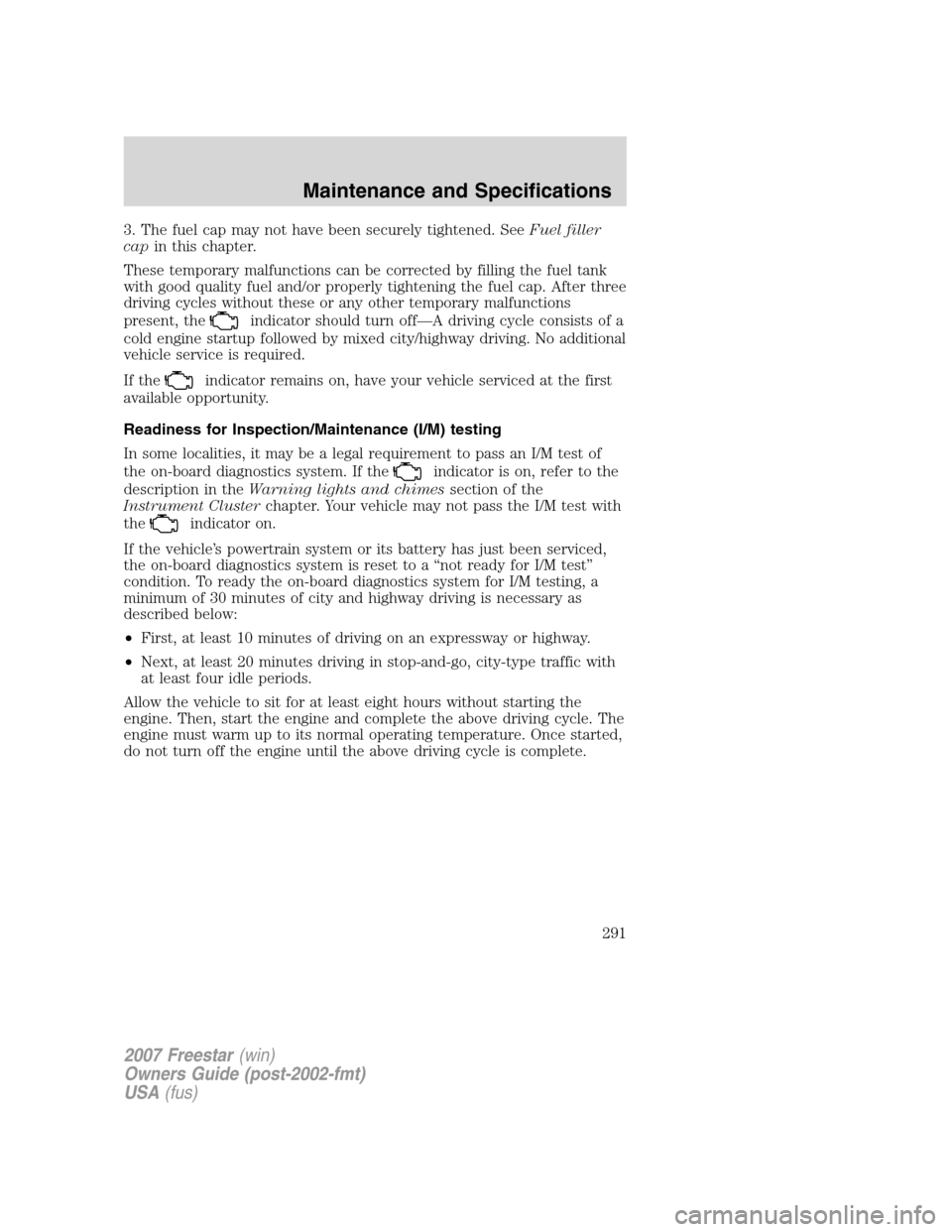
3. The fuel cap may not have been securely tightened. SeeFuel filler
capin this chapter.
These temporary malfunctions can be corrected by filling the fuel tank
with good quality fuel and/or properly tightening the fuel cap. After three
driving cycles without these or any other temporary malfunctions
present, the
indicator should turn off—A driving cycle consists of a
cold engine startup followed by mixed city/highway driving. No additional
vehicle service is required.
If the
indicator remains on, have your vehicle serviced at the first
available opportunity.
Readiness for Inspection/Maintenance (I/M) testing
In some localities, it may be a legal requirement to pass an I/M test of
the on-board diagnostics system. If the
indicator is on, refer to the
description in theWarning lights and chimessection of the
Instrument Clusterchapter. Your vehicle may not pass the I/M test with
the
indicator on.
If the vehicle’s powertrain system or its battery has just been serviced,
the on-board diagnostics system is reset to a “not ready for I/M test”
condition. To ready the on-board diagnostics system for I/M testing, a
minimum of 30 minutes of city and highway driving is necessary as
described below:
•First, at least 10 minutes of driving on an expressway or highway.
•Next, at least 20 minutes driving in stop-and-go, city-type traffic with
at least four idle periods.
Allow the vehicle to sit for at least eight hours without starting the
engine. Then, start the engine and complete the above driving cycle. The
engine must warm up to its normal operating temperature. Once started,
do not turn off the engine until the above driving cycle is complete.
2007 Freestar(win)
Owners Guide (post-2002-fmt)
USA(fus)
Maintenance and Specifications
291
Page 310 of 312

headlamps .................................45
headlamps, flash to pass ..........46
instrument panel, dimming .....47
interior lamps .....................49–51
replacing bulbs ...................52, 55
Lane change indicator
(see Turn signal) ........................49
Liftgate ............................87–88, 92
remote release ..................95, 101
Lights, warning and indicator ....10
anti-lock brakes (ABS) ..........215
Load limits .................................200
Locks
autolock .....................................96
childproof ..................................98
doors ..........................................95
Lubricant specifications ...........300
Lug nuts ....................................245
Luggage rack ...............................92
Lumbar support, seats .............115
M
Message center .....................78–79
english/metric button ...............81
system check button ................81
warning messages .....................82
Mirrors .........................................69
automatic dimming rearview
mirror ........................................69
fold away ...................................70
heated ........................................70
programmable memory ..........102
side view mirrors (power) .......69
signal .........................................70
Motorcraft parts ........265, 281, 299
O
Octane rating ............................285Oil (see Engine oil) ..................271
Overdrive ...................................220
P
Parking brake ............................216
Parts (see Motorcraft parts) ....299
Passenger Occupant
Classification Sensor .................139
Pedals (see Power
adjustable foot pedals) ...............71
Power adjustable foot pedals .....71
Power distribution box
(see Fuses) ...............................231
Power door locks ..................95–96
Power liftgate ......................88, 101
Power mirrors .............................69
Power point .................................66
Power steering ..........................218
fluid, checking and adding ....292
fluid, refill capacity ................300
fluid, specifications .................300
Power Windows ...........................67
R
Radio ..........................19, 21, 24, 27
Relays ........................................227
Remote entry system .........98, 100
illuminated entry ............104–105
locking/unlocking
doors ................................100–101
panic alarm .............................102
replacement/additional
transmitters .............................103
replacing the batteries ...........103
Reverse sensing system ...........222
2007 Freestar(win)
Owners Guide (post-2002-fmt)
USA(fus)
Index
310
Page 312 of 312
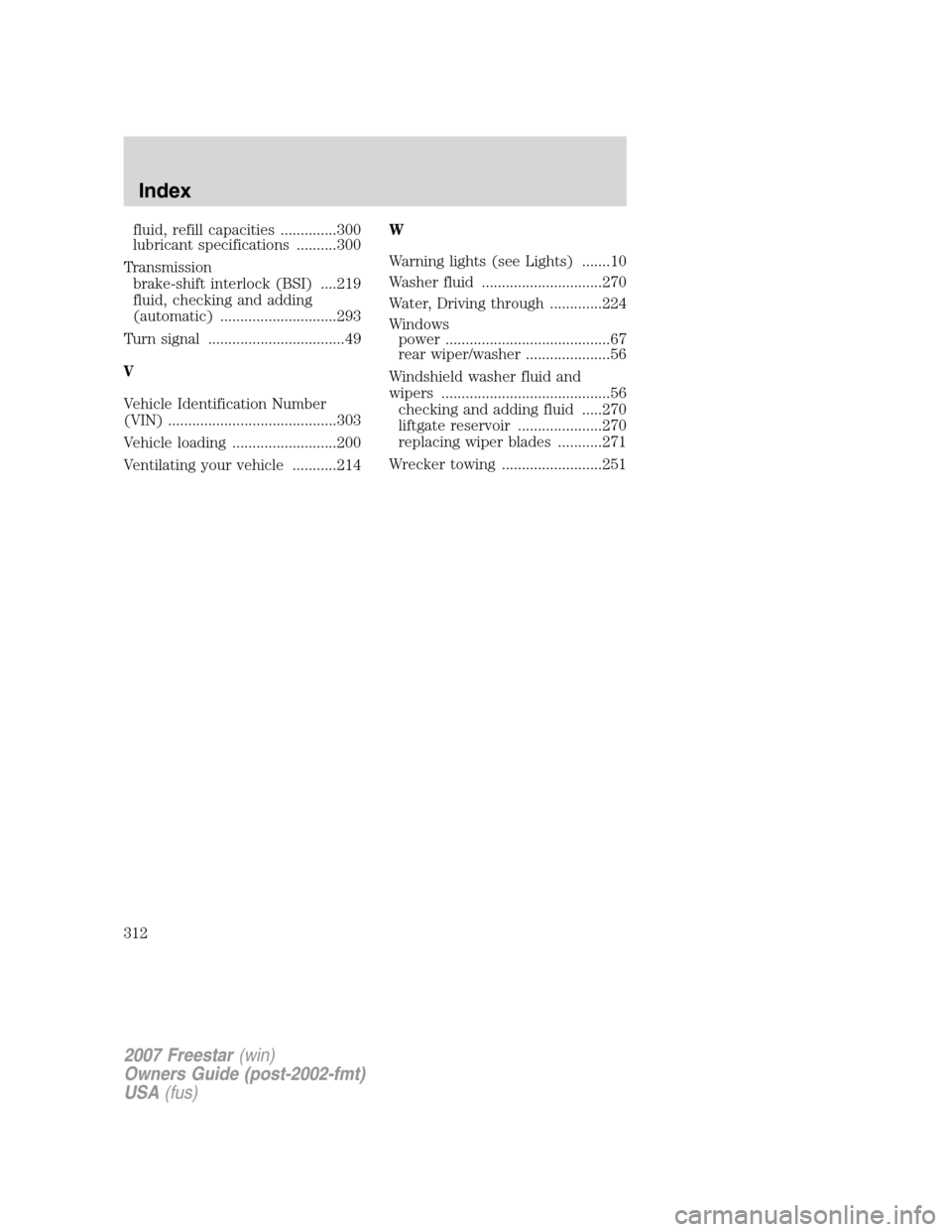
fluid, refill capacities ..............300
lubricant specifications ..........300
Transmission
brake-shift interlock (BSI) ....219
fluid, checking and adding
(automatic) .............................293
Turn signal ..................................49
V
Vehicle Identification Number
(VIN) ..........................................303
Vehicle loading ..........................200
Ventilating your vehicle ...........214W
Warning lights (see Lights) .......10
Washer fluid ..............................270
Water, Driving through .............224
Windows
power .........................................67
rear wiper/washer .....................56
Windshield washer fluid and
wipers ..........................................56
checking and adding fluid .....270
liftgate reservoir .....................270
replacing wiper blades ...........271
Wrecker towing .........................251
2007 Freestar(win)
Owners Guide (post-2002-fmt)
USA(fus)
Index
312